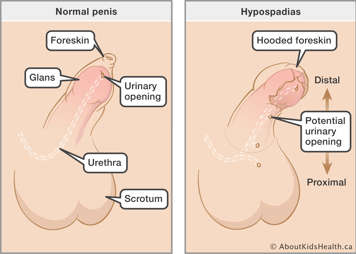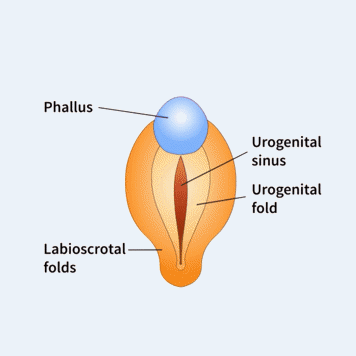What is hypospadias?
Hypospadias is a congenital (present at birth) condition affecting the penis. It is a common birth abnormality in boys. It occurs when parts of the penis do not form completely. Sometimes when boys are born, the urinary opening of the penis (meatus) is not at the tip. Instead, it is lower on the head of the penis or along the undersurface of the penis. In more rare cases, the urinary opening is on the scrotum or at the perineum. The perineum is the area between the scrotum and the anus.
If your child was born with hypospadias, the foreskin will usually appear as a hood on the top of the penis, with no foreskin on the undersurface of the penis. The penis may also have varying degrees of curvature. Together, the hypospadias urinary opening and the curvature may affect their ability to urinate (pee) in a single straight stream. The degree of hypospadias may also affect the natural sexual function of the penis; however, fertility is usually unaffected.
There are two general types of hypospadias based on the location of the urinary opening: distal (mild) hypospadias and proximal (severe) hypospadias.


To see more about how hypospadias forms, visit How Sex Development Works under Conditions > Hypospadias.
Hypospadias may not be noticed at first
Hypospadias may not be noticed at first if the urinary opening is very close to the usual position at the head of the penis or if your child has a complete foreskin. However, in true hypospadias, the foreskin is still hooded on the back and missing on the undersurface of the penis. In either case, circumcision (if desired) should be delayed until your child has been seen by a paediatric urologist.
Causes of hypospadias
Hypospadias occurs in approximately one in 150-300 live male births worldwide. The exact causes of hypospadias are unknown. Hypospadias may involve any number of gene abnormalities. It most often occurs alone, without any other conditions. However, hypospadias may also occur as part of a collection of additional conditions (known as a syndrome).
More recently, chemical and other factors in the environment are thought to be possible factors leading to changes during development that result in hypospadias.
For information on how the sex organs develop, see How Sex Development Works.
Hypospadias management
When managing your child’s hypospadias, two main functional factors will be considered:
- Your child’s ability to urinate (pee) with a single urinary stream that they can easily manage.
- Their ability to have natural penetrative sexual function in the future.
These two functions are the main goals in the management of hypospadias and will be considered when determining whether your child requires surgery. How your child’s hypospadias will be managed is also determined by the type of hypospadias that they have.
For more information on the different types of hypospadias and their management, see:
References
Facts about hypospadias. Centers for Disease Control and Prevention. Retrieved from https://www.cdc.gov/ncbddd/birthdefects/hypospadias.html.